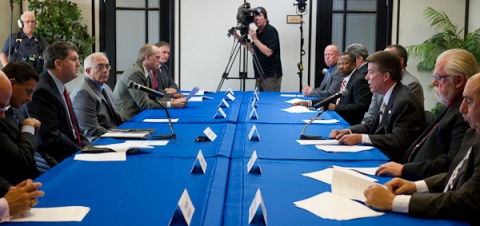
USPS Delivers Financial Presentation
2016 No. 6 – May 12, 2016
You are reading the sixth Contract Update produced and distributed by the NPMHU during the course of 2016 negotiations. These updates, along with the Union’s magazine and monthly bulletins, will keep mail handlers throughout the country informed and involved in the issues raised during this round of bargaining.
This past week the Postal Service presented the NPMHU bargaining team with its official, on-the-record Financial Presentation. This did not include a proposed wage or benefit package for the 2016 National Agreement, but rather focused on the Postal Service’s current financial situation.
The presentation was slightly dated, primarily relying on data from Fiscal Year 2015 (ending on September 30, 2015) and the first quarter of FY2016 to reach its conclusions. It also focused on the termination of the exigent rate increase that led to a reduction in postage rates last month. However, it appears that the projections made in the presentation were fairly accurate. Outlined were the Postal Service’s views on the root causes of its financial instability, the steps it has taken thus far to deal with this financial situation, and the additional actions that it believes are still necessary to cope with the formidable financial challenges that lie ahead.
Unsurprisingly, according to the Postal Service, the financial outlook is not great. The agency is currently operating under a total liability of $101 billion. It has little hope of paying back its debts in the near future, and is virtually locked out of borrowing more money from Congress.
This is nothing new. In fact, FY15 marked the ninth consecutive year of losses for the Postal Service. By 2018, it may face insolvency or be forced to default.
These losses, according to the Postal Service, are caused primarily by the rapid decline in mail volume – especially first class mail. The Postal Service hopes to offset this volume decline by relying on the continuing increase in standard mail, as well as shipping and packages.
Unfortunately, that will be a tall order. Although the positive volume in both standard and package mail has been noticeable in recent years, their respective rates of increase would have to more than double to break even when compared to the loss in first-class mail. An increase of that proportion has never happened in the history of the Postal Service.
By far the largest expense of the Postal Service, of course, is that of labor. Labor costs, more specifically wages and benefits for all employees, account for nearly 80 percent of total Postal Service expenses. Mail handlers make up 6 percent of labor costs, and 5 percent of total costs.
As a result, the Postal Service continues to implement numerous cost cutting initiatives, many of which affect mail handlers. Between 2007 and 2015, it slashed the career workforce by 29 percent, and increased the size of its non-career workforce by 31 percent. Total workhours are also down 23 percent.
The Postal Service also sees value in reviving its capital investments. While cutting costs, the agency has to act simultaneously to update equipment, repair facilities, and deploy new machinery. It sees these investments as both sustainable and necessary.
Achievement of the Postal Service’s five-year plan, according to the Postal Service, is critical to its success. If everything goes according to plan, the Postal Service believes it will be able to increase revenue and stave off default.
The Postal Service also outlined a series of marketing strategies it has recently implemented, apparently to some success. Innovation is essential to staying competitive, even if some of these strategies might be contrary to the interest of certain union members. At some point during the next few years, for example, the Postal Service expects to press forward with its closings and consolidations of mail processing facilities.
Notwithstanding the Postal Service’s pessimistic presentation, the bottom line is that the economic condition of the Postal Service has improved since the last round of bargaining in 2011, with operational surpluses during the past few years. Revenues are increasing, and operational costs are decreasing, if only marginally.
A financially stable Postal Service certainly is in the best interest of the mail handler craft. The question remains, however, whether the economic proposals put forth by USPS management during the last week of bargaining, either individually or collectively, will represent the best course of action for the future of the Postal Service and for all mail handlers.
PLEASE POST!!
- Jefferson Peppers - Vice President - Central Region
- John Gibson - Vice President - Eastern Region
- David Wilkin - Vice President - Northwestern Region
- Lawrence Sapp - Vice President - Western Region
